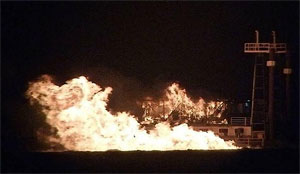The dredge Jonathon King Boyd was positioned over a natural gas pipeline in Matagorda Bay, Texas, when its crew noticed bubbles coming from the water. The vessel’s port spud had inadvertently punctured the buried gas line.
“As the crew prepared to move the dredge and as the leverman was raising the port spud, a geyser of gas and water — 35 to 40 feet high by crew accounts — erupted from the stern of the vessel,” the National Transportation Safety Board (NTSB) said in its investigation report.
“Shortly thereafter,” the report continued, “fire erupted near the stern of the dredge port side. All 10 crewmembers were accounted for.”
The incident occurred April 17, 2018, at 2014 about 1.5 miles offshore from Port O’Connor, Texas. It caused a massive fire that destroyed the 130-foot dredge as well as its 400-hp tender, Bayou Chevron. Total damage to the vessels exceeded $5.5 million, while the gas pipeline owned by Genesis Energy required $1.7 million in repairs.
NTSB investigators learned that supervisors at dredge owner RLB Contracting of Port Lavaca, Texas, failed to notify crew about the pipeline near their worksite.
“(The) probable cause of the fire aboard the cutter suction dredge Jonathon King Boyd was RLB Contracting’s failure to inform the crew about utilities in the area due to ineffective oversight, which led to dropping a spud onto a buried submarine pipeline, causing natural gas to release and ignite,” the NTSB said.
The U.S. Army Corps of Engineers hired RLB Contracting to remove nearly 250,000 cubic yards of sand in the Gulf Intracoastal Waterway. Much of that material was moved through 8,000 feet of pipeline for a nearby beach replenishment project in Port O’Connor. The project was part of a multi-option contract awarded by the Army Corps to dig the channel 14 to 16 feet deep.
Crew aboard the dredge relied exclusively on a software program to identify and monitor hazards in the places they worked. NTSB investigators determined that shoreside personnel with the company never uploaded Army Corps maps showing the pipeline across the channel they were dredging. The result was that crewmembers did not realize they were positioned atop a pipeline.
“(Although) nautical charts … kept in the lever room and crew galley marked the pipelines in the area, the crew did not use them during dredging (because they did not provide the level of detail needed for dredging operations), nor was there any company policy to do so,” the NTSB said.
Investigators determined RLB Contracting also failed to contact the Texas Notification System as required before starting on that section of the dredge project.
“RLB Contracting relied on a single shoreside individual (the production engineer) to carry out appropriate notifications and to input the data for the vessel software, which, in this instance, led to a single-point failure,” the NTSB said in its report.
Dredging operations were underway as expected on the day of the incident. The leverman used anchors on the port side and starboard side to control the dredge and the cutter head’s sweeping motion. A single spud on either the port or starboard side would then be dropped to serve as a pivot point. Alternating between port and starboard spuds allowed the dredge to “walk” a few feet before starting a new pass, the report explained.
Jonathon King Boyd advanced this way under control of the night leverman when crew spotted bubbles at the stern about 90 minutes before the fire started. Crew could not smell gas in the 10-mph winds, and they initially believed the discharge pipe had ruptured. The mate examined the line and determined there were no issues. He later asked whether any pipelines were nearby.
“The leverman and engineer went to the galley to look at the nautical charts, where they discovered a charted submarine pipeline at their location,” the report said. “They informed the captain, who then ordered the mate and deck hand … to pick up the anchors and move the dredge away from that location.”
That process was just getting started when the gas geyser erupted at Jonathon King Boyd’s stern. Crew smelled gas and gathered at the muster station on the main deck forward when the gas ignited. All 10 crewmembers escaped to the towing vessel First State, which was nearby carrying a spare discharge pipe.
The fire burned well into the night, and salvage crews confirmed nearly a day later that the blaze was fully extinguished. During the fire, the dredge tender Bayou Chevron also caught fire and became adrift. It was recovered aground more than eight miles from Jonathon King Boyd. Both vessels were destroyed.
Attempts to reach RLB Contracting for comment on the NTSB findings were not successful.

